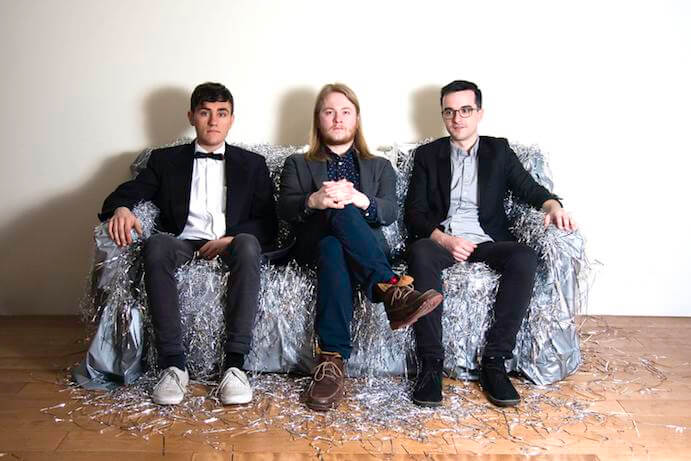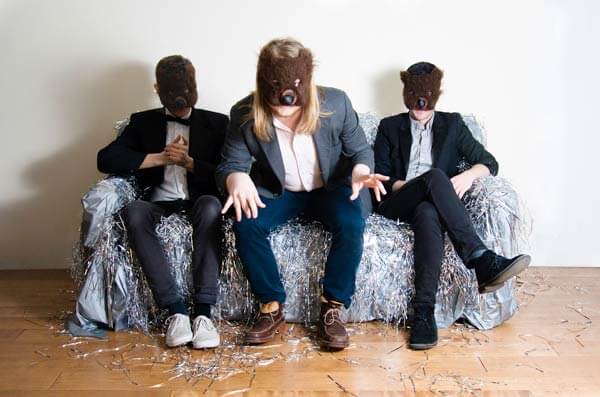Whether you learned by watching Leonardo DiCaprio get clobbered in The Revenant or from your dutiful Scoutmaster or friendly US Park Ranger, it is commonly known that, when hiking in the backcountry, it is inadvisable to stand between a bear and her offspring. On April 18, 2017 from within the subterranean main stage of Manhattan’s (le) poisson rouge, the youthful trio known as Bearthoven exhibited a conviction and commitment to four new works that felt not only analogous but a rival to the dedication of a grizzly to her cubs. The cubs in this case are a series of new compositions commissioned by the ensemble in-part for their debut album, entitled Trios, and released by Cantaloupe Music, a New York-based record label created by the three founders of the eminent Bang on a Can organization: David Lang, Julia Wolfe and Michael Gordon.
Of course, the (musical) backcountry adventurers who had assembled for this event remained safe from harm, thanks to the fact that the group is neither bear-like individually nor as a unit (the name as I understand it is simply a pun for the sake of making one). In their focused presentation, there seemed to be no room at all to come between the performers and their progeny; newly minted compositions by Fjóla Evans, Scott Wollschleger, Brooks Frederickson, and Adrian Knight.
Bearthoven is comprised of pianist Karl Larson, bassist Pat Swoboda, and drummer/percussionist Matt Evans. While this instrumentation is familiar at a glance (the group is essentially a disembodied rhythm section), its make-up is rather unique in the context of the community it endeavors to serve. The ensemble’s mission statement explains, “Bearthoven’s instrumentation, while a clear reference to jazz and pop idioms, is intended to serve as an access point for the current listener…[and] invites composers to explore their cultural relationship with the instrumentation, creating a dialogue between their compositional voice and their own associations with piano, bass, and percussion.”

Bearthoven
Whether this so-called access point leads into or out of the pop and jazz idioms is an interesting question to ponder. Does this portal encourage a departure from common contemporary classical paradigms and ensemble configurations (the ever present string quartet or the inescapable “Pierrot” ensemble) by encouraging the academic to explore his or her voice in a passively familiar but underutilized manner? Or, is it an escape hatch from the cliches of pop and jazz, into the expansive, genre-transcendent universe in which we find ourselves; an exit through the rhythm section meant to guide the pop-rock influenced composer into the unexplored artistic dimensions that may surround them? If the evening’s program indicated anything, it is that the chosen composers have made no compromises in exhibiting diverse and thought provoking individuality, truly free of apparent association and holistically engaged in crafting new and elegant sonorities for this wonderful ensemble.
The show opened with a meditative performance by composer-collaborator Fjóla Evans comprised of long, delicate tones for solo cello woven into a tapestry of prerecorded and electronic sounds. The piece was performed before a projected video backdrop depicting some kind of European peasant dance troupe, which seemed in a way connected to the sampled sounds throughout that at times conjured images of folkish vocalizations. Bearthoven’s set opened with a piece entitled Shoaling also by Evans and commissioned for the album. The work emerged from a very similar creative space as Evans’ solo opener. Expanding and contracting under long, expressive tones and subtle textures, the piece develops a ritualistic, panel-like structure that establishes an atmosphere of subtle anxiety, like trying to recall a memory that is perched at the tip of the tongue but can never be articulated.

Fjóla Evans
Composer Scott Wollschleger provided the next work, which was commissioned by the group but is not included on the album. Wollschleger’s piece, called American Dream, offered a dramatic contrast to Evans’ undulating waves with an expressionistic landscape of pulsating, dissonant tone clusters (produced by chromatic pitch pipes), twinkling chimes and bells, and earthen sonorities that emanated from grinding cast iron and terra cotta. There was a stunning, almost hypnotic quality to Wollschleger’s work, that felt at times like a religious rite and at others like an exploration of horror movie tropes. At the work’s climactic peak, a nebula of droning textures emerge from the vibraphone, assisted by what appeared to be wind-up toys. It was in this moment that the piece transcended its own spooky narrative and seemed to conclude like a magic trick.
The final two works, entitled The Ringing World and Undertoad by Adrian Knight and Brooks Frederickson respectively, provided further contrast and exhibited Bearthoven’s thorough ability both to inspire (per the ensemble’s mission statement) and execute with thoughtful precision. Indeed, it is in this excellent group’s penchant to inspire that the greatest depths of their influence may be realized. Bearthoven does not merely provide a non-standard instrumentation to a community of creators largely entrenched in more traditional tropes, but motivates in this community a new way of thinking about how to approach the production of sound without being bound to an approach that isolates one ensemble or another into silos or categories.
Bearthoven is not just a piano, a bass and some drums — it seems greater than the sum of its parts; a kind of chameleon that is both the subject and the object of the creative process, a synergistic unit that informs and becomes the art that is created at its behest.




















